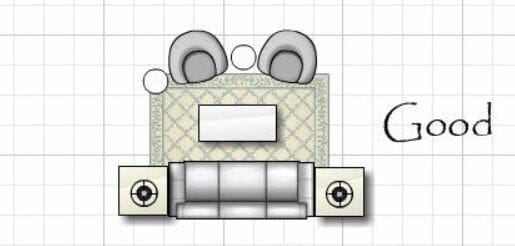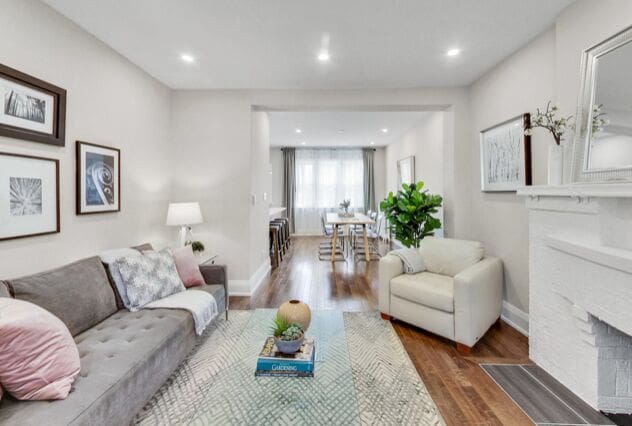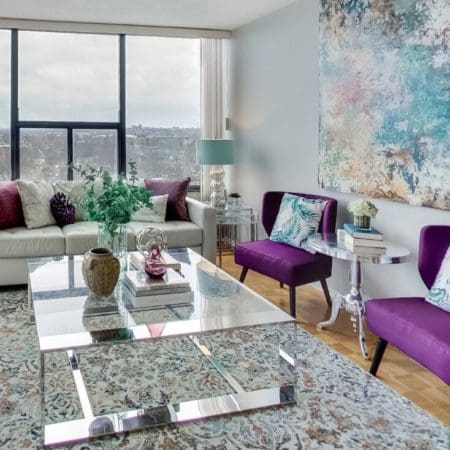If the kitchen is the heart of the home, then what major organ can we assign to the living room?
Living rooms require more furniture than just about any other room in the home. As a stager who decorates several living rooms a week, I was excited to write about an essential part of my favourite room in the home: area rugs. Finding the perfect rug isn’t always easy, but it’s much more manageable if you know where to start. It’s not uncommon for me to build a room around a rug, and if you happen to be starting your room from scratch, you might consider doing the same.
Size Matters

Just like the shoe at Cinderella’s ball, one size doesn’t fit all. Before we can even begin talking about material, colour, texture or pattern, we must first know exactly what size rug will suit our space. I’m not the first or last person to write about rug size, and there is some debate as to what constitutes a perfectly sized rug, but through trial and error I’m confident mine is the right way:
Pro Tip: For any room to feel cohesive, all or most of the furniture within that seating area should be touching the rug with the front legs of the furniture resting on the rug by at least three to six inches.
There is a school of thought that says even the back legs of the furniture should rest on the rug, but that is primarily for huge rooms with multiple seating areas in my opinion, so unless you’re living in a mansion, those rules don’t apply. Lay out the furniture in the room, or tape it off if it’s yet to be purchased or delivered; then using your measuring tape determine what rug will adequately fit your space. Area rugs are increasingly manufactured in dimensions other than 5×7, 6×9, and 8×10, but they’re always very close to those standard sizes. The 5×7 version of the rug of your dreams may be several hundred dollars cheaper than the 6×9, but you’ll do yourself no favours if your carpet looks like an island at sea in your space. Just remember, your guests’ feet should be on the same rug when they’re chatting in the same room.
Of course, with every rule, there is an exception. In this case, it’s irregular shaped rugs. The best example of an irregular shaped rug is a cowhide. They’re incredibly popular at the moment, definitely have a cool factor, and are more appropriate for casual spaces. Rugs that fill a space like a paint splatter do not unify a space in the same way traditional rectangular rugs do and are perfectly fine to float like an island in the centre of a room. They still look best when tethered to the furniture around them though, so I suggest having one portion of the rug positioned a few inches under your central seating arrangement (most often the couch).
It’s All in the Touch

The biggest decision about the material of your area rug is whether it is natural fibre or synthetic. Natural rugs, as you might expect, are more expensive, but aren’t necessarily better for your space. For the most part, natural fibre rugs are rugs that are made from wool, cotton, jute (sisal), or silk. Synthetic rugs are typically nylon, polypropylene, or polyester. For a formal living room, I love using a wool rug. They tend to be thicker, are naturally less absorbent, and feel luxurious under your foot. You’ll want to consider how much traffic your room will receive before choosing and it never helps to do a little research on the product you plan to buy. I often use viscose blend rugs for rooms I stage because they look like silk and are significantly cheaper, though they may not last as long in high traffic areas. If you’re someone who likes to redecorate every couple of years, you may not want to invest thousands of dollars in a rug to get the look you desire. As is the case with most of your home furnishings, investment pieces may stand the test of time, but none of that matters if your tastes are continually changing.
Considering Colour

For many people, the material of the area rug is an afterthought, even though it shouldn’t be. It’s all about the colour and pattern. With so many colours and patterns to choose from, where do you start? If you have your furniture and some colour in a room already, there’s your answer! Dark couches look best on light rugs, and the opposite is true. The pattern on your walls? Keep it simple on your rug. The dominant colour in the rug should not be the same as the dominant colour in your room. It should be present and complimentary, but having the same rug and wall colour will not be the best look for your space. I like choosing a rug that has a few colours present and an abstract pattern. When you choose a rug like this, it’s easy to build a room around it. Choose a colour from the rug that you like and use some of it on your couch with pillows and a throw; then add a complementary colour to the scheme that may or may not be found in the rug. Rugs can have several colours and still be neutral, so as not to worry if the colour isn’t your thing. You may find hints of gold, blue, or orange, woven into an otherwise neutral rug, and it’s perfectly acceptable to use those subtle hints as jumping off points for the rest of your room, but by no means is it necessary. The colours in your rug don’t need to be found anywhere else in the space, but using them as a guide can simplify things.
Area rugs are so important to space because they physically pull the pieces of our rooms together, unifying the space, and allowing us to put art under our feet. The size and design (colour and pattern) of the rug are essential elements for the esthetic of the space, and the material and type of rug are more important for the function. Start with one aspect and then consider the other. It never hurts to do some research and consider trying a few in your space if you get the chance before committing. In many ways, living rooms are to a home, what rugs are to a room. They can unify a home by pulling together different elements: they showcase the colour scheme of the home, display pictures of the family, and display how they live. If the kitchen is the heart of the home, then maybe the living room is the skin. Why not tattoo something beautiful onto it with the loveliest rug you can find.
Author: Kiel Storms. Read more about him here.
